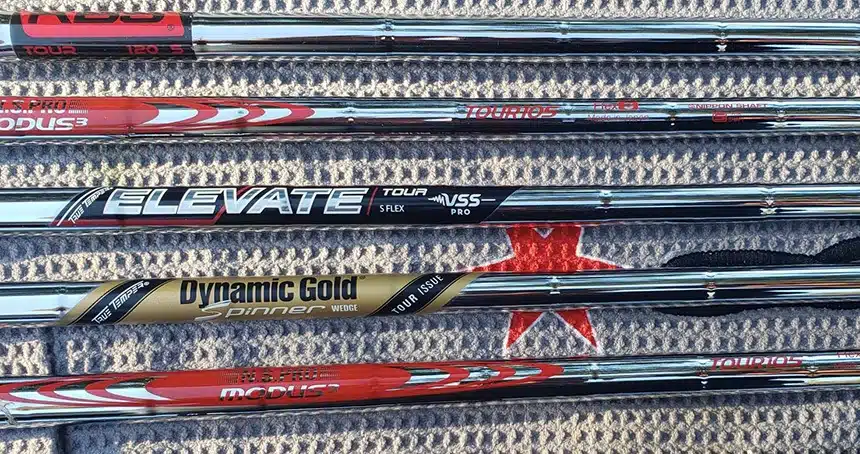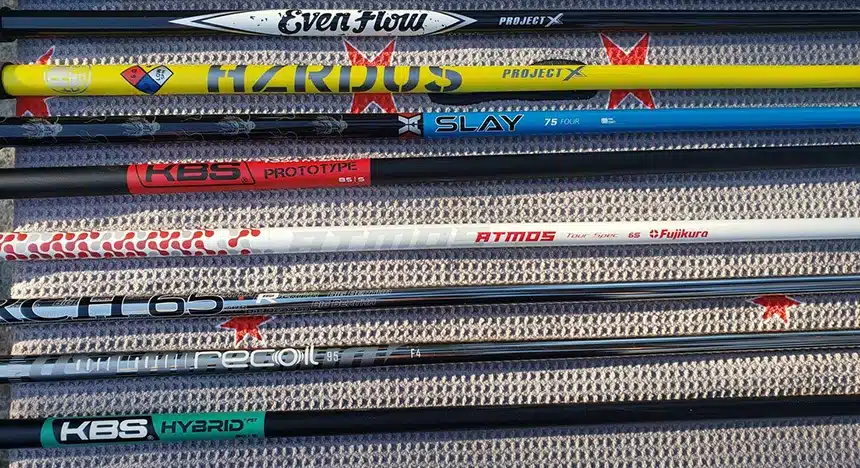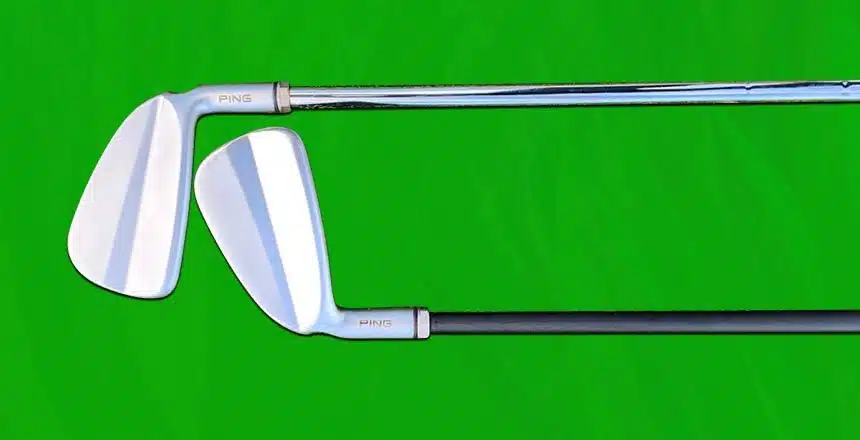Fast, competitive players choose steel while slower and older golfers go with graphite shafts. The former is exceptionally consistent and the latter overly flexible and lightweight. These are generalizations that are almost 100-percent accurate.
But that was just the gist of the whole comparison of graphite vs. steel shafts. There’s obviously more to it in terms of several parameters when selecting between the two golf club shaft materials.
Now you can always decide to get a professional club fitting where a ‘shaft optimizer’ will analyze your golf swing and then based on that, provide the most suitable recommendations FOR YOU.
Or you could just read this comprehensive, straightforward guide to determine how to pick the right golf shaft. It’s free of cost!
In This Post
Common ground exists between steel and graphite golf club shafts. Such as kick point, which is responsible for ball flight. For example, low kick point leads to high ball flight, high kick point equals low ball flight, and mid kick point produces mid ball flight.
Another shared characteristic here is torque. This just refers to the extent to which the bending/twisting of the shaft happens.
Lower torque would mean less twisting, which is preferred by PGA Tour players or other such advanced golfers. With a lower torque, their faster swing speed can be handled better, so controlling ball flight becomes easier for them.
Steel Shafts – An Overview

This shaft, due to its very bland design, was mainly picked by only high-speed, better golfers. But things have changed now in the age of modern golf with steel shafts becoming relatively more lightweight. Lighter than their traditional, old weight of 130 grams.
As of now, it’s not uncommon to come across steel shafts that weigh halfway between the 80-90 grams range.
New metals are now as strong but they’re also more lightweight. But the ‘higher strength’ part is what offers more control. And that’s the reason why steel shafts cannot be made any lighter. Otherwise, control gets compromised. The weight of this shaft is primarily the very thing that makes it so much more stable (than graphite) to handle faster swing speeds.
Pros of Steel Shafts
- More vibrations (i.e. feedback) reach your hands.
- Based on this impact and feel, you can tell what went right or wrong.
- Better equipped, because of the heavier weight, to handle higher swing speeds and a faster swing tempo.
- More control, once again, because of the heavier weight.
- Less expensive in comparison to graphite.
Cons of Steel Shafts
- Due to vibrations, mis-hits tend to sting the hands.
- The higher weight slightly reduces swing speed by 4 mph (roughly 10 yards).
- Heavier weight plus more rigidity of steel – not suitable for golfers with chronic muscle or bone problems in the shoulders, arms, or hands.
Graphite Shafts – An Overview

These shafts, when first released, were slammed because of the lack of consistency and durability. Also, graphite shafts back them were also criticized for hitting the golf ball too long.
Now let’s come back to the present where graphite shafts are made using a different kind of carbon composite capable of offering not just consistency and durability but also distance control.
Modern-day graphite shafts are even more lightweight than before – between 50 and 65 grams only. And some are even lighter!
Also, did you know that Bryson DeChambeau’s golf clubs (all of them except for the putter of course) back in the U.S. Open tournament of 2020 were graphite-shafted? And he’s a LOOOONNGG hitter indeed.
Pros of Graphite Shafts
- More lightweight than steel, hence increases swing speed and boosts distance (by 5 yards with each golf club).
- Because of the lighter weight, graphite shafts are easier to swing.
- Muffled vibrations on off-center shots. Thus, less painful in the hands, arms, and shoulders. So the best option for those with joint/muscle problems.
Cons of Graphite Shafts
- Less rigid, hence more flexibility and whip. And while this is the most advantageous in the case of a well-grooved golf swing, it’s not the best for accuracy as it tends to exaggerate swing faults.
- More expensive than steel.
Differences Between Graphite Shaft and Steel Shaft
It’s simple – graphite (made of composite) is more lightweight, thus easier to swing while steel is more workable, stable, and sturdier.
But then here are more specific categories of differences between the two golf club shaft materials…
Shaft Weight
Generally, graphite shafts have a more lightweight construction than their steel counterparts. And with a lighter weight like graphite, you can actually promote a faster swing speed. Gaining extra yardages (as a result of hitting with greater force) with more lightweight graphite is why the best drivers for beginners are all graphite-shafted.
Ball Flight
The type of shaft used in a golf club also determines ball flight. On the one hand, there’s graphite for generating a higher ball flight. And on the other, you have steel shafts for producing a lower and more controlled ball flight.
In the case of a higher launch, your shot is most likely to also travel a longer distance. But then this higher ball flight is also accompanied by a lack of shot control, which fast-speed players do not like. But then beginners and high handicappers are not so much concerned with a controlled ball flight as they are with getting their shots airborne more effortlessly.
However, low-handicap, high-speed, and more advanced golfers prefer more control since they are already highly proficient at hitting both low and high shots whenever they like.
Shaft Flex
In the case of both steel and graphite shafts, different flex options are available. The sincerely stiff variety is Extra Stiff while Senior-flex golf shafts are more flexible. You’ll also find ladies’ golf clubs equipped with greater shaft flex like the latter above.
Typically, you see steel-shafted clubs with a stiffer flex. And this only makes sense because the higher your swing speed, the stiffer your golf club shaft flex should be.
Who Should Use Graphite Shafts?
Additional ball speed is the main reason for choosing a graphite shaft. So by that logic, the following types of golfers…
- If your swing speed is slower.
- If you’re a beginner and/or high-handicap golfer who could use extra ‘mis-hit’ forgiveness. (‘Graphite vs steel shaft for beginners’ debate is settled then!)
- If you tend to feel fatigued toward the end of your round of golf.
- If you have arthritis and can’t tolerate the sting of vibrations at impact.
- If you really struggle to get your shots to launch into the air.
- If boosting distance is your #1 priority.
- If you’re a slow-speed female golfer or a junior player.
Who Should Use Steel Shafts?
With a steel shaft, you get more precision and control. So what kinds of players benefit the most from these advantages…
- Golfers with a fast swing speed.
- Strong players and athletes.
- More advanced golfers who desire more feedback and feel in the swing.
- Players who want a more controlled ball flight plus greater launch control as well.
- If you know how to work the golf ball right and left, steel shafts are the way to go!
- Those that prioritize accuracy over distance.
- Golfers bad at spin control and even shot direction control.
What Types of Golf Clubs Need A Graphite Shaft?
Should your complete set of golf clubs be either graphite or steel-shafted? Or should you include a blend of both? Time to find out which clubs are better off equipped with a graphite shaft!
1. Woods (including hybrids)
No doubt, every wood in there must have a graphite shaft. And this applies to golfers with a faster swing speed as well because lightweight graphite is the most capable of generating the clubhead speed as well as the distance required.
Also, woods have a longer length than irons. So a steel-shafted wood will then automatically become more difficult to swing.
2. Irons
Should I play graphite shafts in my irons? These golf clubs can either be steel-shafted or graphite-shafted. Even a mix of both seems fine.
Actually, it all depends on YOUR game and swing speed. When swing speed is slower, choose graphite of course (more lightweight, easier to swing). Otherwise, go with steel-shafted irons (for more precision and control).
3. Wedges
Your set of golf irons are all outfitted with a graphite shaft, for example, then it only seems logical and beneficial to use wedges of the same shaft material. Graphite-shafted golf wedges are indeed gaining popularity over the past few years due to top brands like Callaway and Cleveland (they now have stock ‘graphite’ options as well).
But here’s the thing – with wedges, shot control is the most important factor. So that should explain why steel is a more preferred choice. However, putting spin or getting out of bunkers, all these demand a higher clubhead speed too. And this is something that’s easier to accomplish with graphite and not a steel shaft, especially if you’re a slow-speed golfer.
4. Putters
There’s the Odyssey Stroke Lab Versa Putter that’s designed with a shaft partly steel and partly graphite. The advantage of which is the best of both worlds!
In the majority of scenarios though, steel-shafted putters are more commonly used. So if the putter you own is steel, no need to really switch to graphite.
Summing-Up
So then should beginners and high handicappers always select graphite shafts? If you could use the extra ‘mis-hit’ forgiveness, clubhead speed, and also the easier launch provided only by graphite, then the answer is YES.
On the other hand, if your swing speed is fast, no matter how experienced or inexperienced you may be, then it means you don’t struggle with getting the golf ball airborne. In that case, don’t pick graphite as it’s most likely then to mess with control and consistency.
Now it goes without saying that both steel and graphite come with their own set of pros and cons. So the choice between the two actually depends on YOUR swing speed, style of play, and other personal preferences. But, on the whole, steel is for Tour pros and amateur golfers while graphite for beginners who lack clubhead speed.


Graphite shafts are a great choice for beginners because they are lightweight and easy to use. Steel shafts are also a good choice for beginners, but they can be more difficult to use.